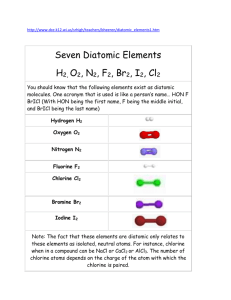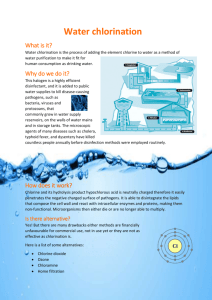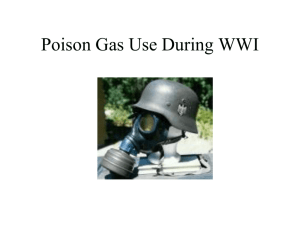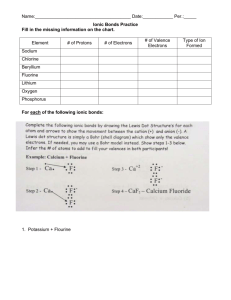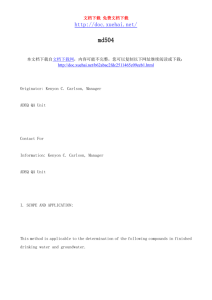DBP
advertisement
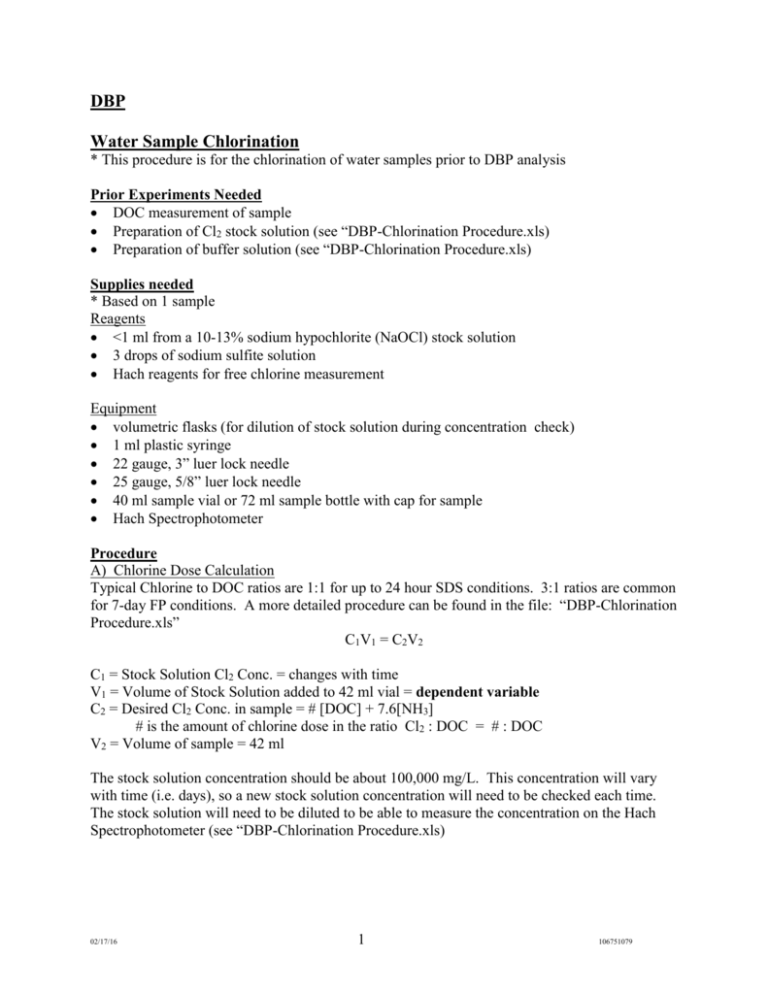
DBP Water Sample Chlorination * This procedure is for the chlorination of water samples prior to DBP analysis Prior Experiments Needed DOC measurement of sample Preparation of Cl2 stock solution (see “DBP-Chlorination Procedure.xls) Preparation of buffer solution (see “DBP-Chlorination Procedure.xls) Supplies needed * Based on 1 sample Reagents <1 ml from a 10-13% sodium hypochlorite (NaOCl) stock solution 3 drops of sodium sulfite solution Hach reagents for free chlorine measurement Equipment volumetric flasks (for dilution of stock solution during concentration check) 1 ml plastic syringe 22 gauge, 3” luer lock needle 25 gauge, 5/8” luer lock needle 40 ml sample vial or 72 ml sample bottle with cap for sample Hach Spectrophotometer Procedure A) Chlorine Dose Calculation Typical Chlorine to DOC ratios are 1:1 for up to 24 hour SDS conditions. 3:1 ratios are common for 7-day FP conditions. A more detailed procedure can be found in the file: “DBP-Chlorination Procedure.xls” C1V1 = C2V2 C1 = Stock Solution Cl2 Conc. = changes with time V1 = Volume of Stock Solution added to 42 ml vial = dependent variable C2 = Desired Cl2 Conc. in sample = # [DOC] + 7.6[NH3] # is the amount of chlorine dose in the ratio Cl2 : DOC = # : DOC V2 = Volume of sample = 42 ml The stock solution concentration should be about 100,000 mg/L. This concentration will vary with time (i.e. days), so a new stock solution concentration will need to be checked each time. The stock solution will need to be diluted to be able to measure the concentration on the Hach Spectrophotometer (see “DBP-Chlorination Procedure.xls) 02/17/16 1 106751079 B) Sample Chlorination 1) Measure the sample DOC 2) Adjust the pH of the sample to the desired pH (This is most easily accomplished by adjusting a larger volume needed, i.e. 100 or 200 ml, and wasting the extra sample). Then add the appropriate amount of phosphate buffer (see “Buffer Solution” binder section). The buffer concentration in the sample should usually be 1 mM. 3) Fill sample vial to top so no headspace is present. This can best be achieved by filling the sample vial just above the top and slip the septa on from the side. 4) Place a 5/8” - 25 gauge needle in the septa of the vial (Figure 1) 5) Inject the appropriate chlorine dose via a 3” - 22 guage needle plunged to the bottom of the sample vial (Figure 1). During the injection, pull the dosing needle upward to more evenly distribute the chlorine in the sample. The chlorine will displace an equal amount of sample out the 5/8” needle. 6) Store sample at 20oC for desired time period 5/8” exhaust needle 3” injection needle Figure 1 C) Chlorine Residual Measurement Most often, the free chlorine residual needs to be measured to ensure that all the chlorine was not consumed in the reaction, leading to a chlorine limited reaction. The free chlorine measurement must be performed prior to any DBP analysis where the free chlorine must first be bound. D) Stop chlorination To end the chlorination process by binding the free chlorine, add 3 drops of sodium sulfite solution to (10 g Na2SO3 / 100 ml MQ) to the 40 ml samples. QA/QC DBP analysis, following the chlorination of samples, can have a high variability in results due to the many steps and variables in the process. It is recommended that triplicate samples be provided for a minimum of 10% of the samples to quantify the variability in results. Duplication for all samples is ideal, but very time consuming. 02/17/16 2 106751079
